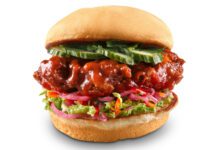Find out what operators are doing to appeal to the growing environmental movement.
How are operations becoming more environmentally friendly?
Jay Gould: Of the 16 [South St. Burger Co.] stores we have open, half are Bullfrog-powered, and that’s just a straight cost to us (about $4,000 a month). We switched our ice machines from water-cooled to air-cooled; we have [installed] solar panels at our Markham, [Ont.] store; we’ve got some solar heating in water heating in our Barrie [Ont.] store. Our new store that opened in Bayview Village [in the Greater Toronto Area] is LEED-certified. These are things we think customers appreciate, too.
Carol Patterson: In October 2011, Tim Hortons launched a new recycling program called Cup-To-Tray in Nova Scotia where our hot beverage cups are being collected from all 156 traditional restaurants in the province and converted into our take-out trays. This made Tim Hortons the first quick-service restaurant in Canada to “close the loop” and recycle used cups into another product our company uses. A month later, we expanded the program to Vernon, B.C.
In addition to the Cup-To-Tray program, successful recycling and/or composting initiatives are in place at more than 500 of our restaurants across the country. We encourage guests to participate in these programs by bringing their used cups back to our restaurants and sorting them into the proper compartment of our recycling units. This step is crucial in ensuring materials can be properly recycled and/or composted. As part of our commitment to sustainability and responsibility, we continue to seek innovative solutions to all of the waste created from our business, which includes a continued focus on diverting packaging waste from landfill.
How has take-out packaging changed to feed the green movement?
Gould: Honestly, if there’s a weakness in the industry, [it’s] the availability of recycled content or post-consumer content in our carry-out. Whether it’s carry-out or eaten in, it’s still wasted paper, unless it’s either entirely recyclable or compostable or made from recycled paper. Frankly, we are getting a bit ticked off at that. It’s an antiquated business, and it takes some of the bigger players in the industry to speak up and bring it forward. Our burger wrapper is intentionally just a thin piece of paper — it’s not foil, it’s going to break down. We are conscious of that, and frankly would like to get better; there’s room to get better at it.
Jay Gould is the president of South St. Burger Co. and New York Fries.
Carol Patterson is the manager of Environmental Affairs, Tim Hortons.





















